Tähtitieteellinen yhdistys Ursa
Ilmakehän optiset ilmiöt

Displays
11.4.
A British high pressure took care of the clouds in Central Europe, causing a break in halo events. The greater part of Central and Southern Finland was under thick clouds from an extensive Russian low pressure complex ...as Claudia Hetze, our German colleague informs us. To remind: her meteorology comments have been incorporated in these display descriptions. Only in the north was the cloud more broken, and halos were observed there. Öhman, Korhonen and Palojärvi made observations of 22° halos, but in addition to these, Simo Aikioniemi saw a clear 46° halo and a bit later either 46° halo or supralateral arc. In the Netherlands, Frank Nieuwenhuys in the Hague, and Stefan Jak in Zwolle, kept their eyes open and saw 22° halos as well, just as their Northern colleagues.
Hetze and Hinz observed a faint, modestly developed 46° halo in addition to 22° halo in Chemnitz, as well as Löwenherz. The latter saw the circumzenithal arc and a sun pillar with the thunder cloud of species cumulonimbus capillatus hovering in the background sky in Klettwitz.
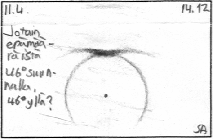
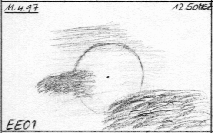
Satellite image: Apr 11, 11:42+13:22 GMT
11./12.4.
Richard Löwenherz in Germany and Simo Aikioniemi in Finland rounded the night as a 1-1 tie result between the networks. Nocturnal target: moon pillar.
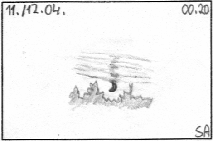
12.4.
Finland lay in a high pressure ridge, which developed between the Russian low pressure complex and the low above the Barents Sea, and profited from the high clouds of both fronts. The basic halo forms were seen all over Finland, not surprisingly. The best single observations contained halos like circumzenithal arc (Korhonen, Piikki and Toivonen) and parhelic circle (Sillanpää and Toivonen). The day showed its best sights to the southern part of the country, but something was offered also to the groups in Oulu and Savukoski.
Thanks to the British high pressure region, large parts of Central Europe had few clouds or were foggy. A long warm front belonging to a low above the Barents Sea produced some Ci-fields over Northern Germany and the Netherlands. Nieuwenhuys in the Hague however saw a solitary 22° tangent arc, but Gerrit Breman succeeded in making observations of two halo forms: sun pillar in the morning and parhelia in the evening. Platelike crystals seem to have been dominating both in Finland and in the Netherlands. Coincidentally same type of crystals had the main role also in Germany, as a few observers saw low activity displays. The best material appeared in the Southern Finland.
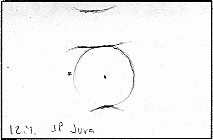
Satellite image: Apr 12, 11:31+13:11 GMT
12./13.4.
Gerrit Breman noticed a 22° halo around the Moon. Similar sight caught the eye of Heino Bardenhagen at Schneverdingen. Things began similarly in Finland's northernmost Savukoski with Tarmo Palojärvi observing 22° halo. Ten minutes later Simo Aikioniemi took notice of the 22° tangent arc as a brightening on the top of the basic ring.
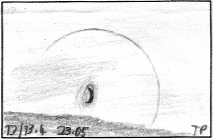
13.4.
The warm front reached Central Europe, yielding many kinds of halos, especially in the East of Germany. The big day of the Germans: 19 observers reported at least some halos. The correlation between high amount of observers and high quality of halos is clearly visible in this case. The greatest halos were seen on quite a little area in southeast parts of the country, but several observers elsewhere in the country were also fortunate to have something worth to turn their heads up to the skies.
The treasures given by celestial deities included a heavy bombardment of halos of unusual radii and very beautiful complex displays with entire, full parhelic circles and 120° parhelia. In the German areas of Lausitz (South from Berlin) and further South in Saxony the cloud material had the most developed crystals, giving possibilities to see some rare forms for the observers in Klettwitz, Pirna, Chemnitz and Schneeberg.
Halos arising from pyramid crystals were observed by Gerald Berthold, Claudia Hetze and Wolfgang Hinz in Chemnitz and by Richard Löwenherz in Klettwitz. Berthold reported 9° halo, 18° lateral arcs and 24° halo. Since the origin mechanisms for the 9° and 24° halos are very close to each other, the ring outside the 22° halo in Berthold's drawing could likely be interpreted as the 24° halo. The same target seems to be apparent in the observations of Hetze and Hinz (as were the 18° effects as well) and indeed in the photographs loaned by Chemnitz to Helsinki. Löwenherz reported only the 9° halo.
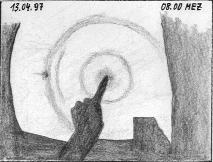
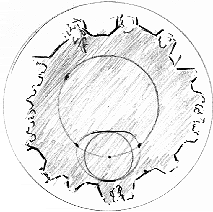
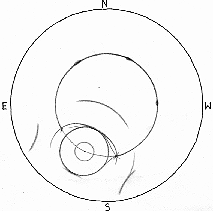
The rarest, most exquisite thing evident is provided by photographs of Wolfgang Hinz and Claudia Hetze, in which a clear brightening is identifiable in the corresponding place of 24° lateral arcs (Können terminology) or to say it otherwise a piece of 24° parhelia (Tape terminology). Whatever name you choose to prefer, it is very special, particularly as caught in Central Europe. A very skilled and motivated observer in Scandinavian latitudes is given a piece of this arc at 24° distance perhaps in average only once every 2-3 years or so.
Near the clouds with pyramidal crystals, there was lounging the cirrostratus with the traditional columns and plates with very high degree of development. The most striking drawings are made by Holger Lau in Pirna and Löwenherz in Klettwitz. Both of them have seen a perfectly developed parhelic circle and at least another 120° parhelion. The circumscribed halo is also very long, and Löwenherz has seen the infralateral arcs as well. No wonder if the Wegener's anthelic arcs would have visited in the sky in some part of the display, although none of the observers have reported this elitist form. Some of the intensity of the anthelion observed by Löwenherz may be powered by the anthelic arcs, as quite often has proved out to be the case in photograph-studied displays of anthelia.
In addition to all those halo forms, the Lowitz arcs are reported by a few observers. On the basis of the Löwenherz's beautiful drawing there's no doubt about the fact that the real Lowitz arcs were on the sky. Congratulations to every observer for nearby the display centre. The interesting point to note is the video recording made by the meteor video recording pioneer Sirko Molau near Berlin at Hönow. He seems to have been far enough of the pyramidal center, but at least Lowitz arcs should be successful documented in the video tape. Another one who caught part of the action was Holger Lau at Pirna who had to satisfy in a beautiful combination of full parhelic circle and full 22° tangent arcs simultaneously. During almost any other day these would have been the biggest catch in Europe.
The Netherlands was also far enough to avoid the German gems. Stefan Jak observed the parhelia in Zwolle. Finland was meanwhile situated in the heart of the Nordic low, and especially Central to Southern Finland lay under thick clouds. Five observers reported the 22° halo. Three of the observations were done in Lapland, and only one of the observers could see anything else: Aikioniemi reported "really promising 22° upper tangent arc" seen through a hole in the layer of lower clouds. Be damned those water droplet clouds! They tend to block meteors, stars and auroras too... Now who would want to buy stratocumulus?
Satellite image: Apr 13, 13:00 GMT
14.4.
The low pressure, with its centre above Finland, sent its long cold-air arm across Central Europe and England and drove away all the halo-producing clouds. Most of the observers in Finland still saw some halos, but none of the observations were that revolutionary as the ones of the day before under the German skies. Still, the hits by Sillanpää and Savolainen improve the overall results; both sirs make the surely incredible claim that they have seen the circumzenithal arc. No doubt they did. Nothing striking either elsewhere in Europe. A few of the most frequent ice crystal lights were scattered visible over Germany and Austria.
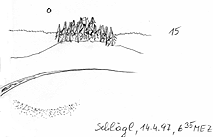
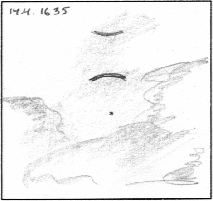
Satellite image: Apr 14, 12:49 GMT
15.4.
Pretty much the same situation. The warm front of a northern low brought ice-crystal clouds and few halos to the Netherlands and Finland. In Eastern parts of Germany some cirrus mixed in with the rest of the clouds of the departing front. Many observers got some basic halos all over Finland. Four observers made an observation of the circumzenithal arc as the rarest halo form of the day. In the Hague, Nieuwenhuys caught a display with 22 ° tangent arc.
The richest displays were probably seen in Germany, where among others Löwenherz was again vigilant to catch his eyes on a combination of the 22° halo, parhelia, 22° upper tangent arc and circumzenithal arc.
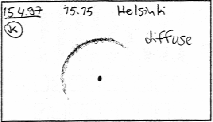
Satellite image: Apr 15, 12:39 GMT
15./16.4.
This lunar halo was seen only in the Netherlands. Frank "23° parroid" Nieuwenhuys detected the 22° halo around the Moon. If you wonder about the extra name of Frank, it is a reminiscence of his 1974 sky conquest of having taken the first ever published photograph of 23° parroid (23° parhelion). Hence if you choose to dislike both the parroid or the parhelion name (as many actually do), you can as well follow the old tradition and refer to it as Nieuwenhuys arc hence adding some juice in the beauty and variety of the complex affair of the present day pyramidal halo nomenclature. Frank's triumph photograph appeared in an article by Peter-Paul Hattinga Verschure in a 1975 issue of Dutch journal Zenit and has been quoted in a variety of recent and upcoming scientific publications, particularly in the upcoming "Light and Color in the Open Air"- conference feature issue of Applied Optics.
European Halo Project | Contents | Previous chapter | Next chapter
-
 Useita halomuotoja II 2.1.2026 klo 20.34; Nivala; Heli Ojalehto
Useita halomuotoja II 2.1.2026 klo 20.34; Nivala; Heli Ojalehto -
 Harvinaisia halomuotoja IV 2.1.2026 klo 19.00; Oulu; Marja Marttila
Harvinaisia halomuotoja IV 2.1.2026 klo 19.00; Oulu; Marja Marttila -
 Useita halomuotoja II 2.1.2026 klo 19.00; Raahe; Irina Jylhä
Useita halomuotoja II 2.1.2026 klo 19.00; Raahe; Irina Jylhä -
 Yksi halomuoto I 2.1.2026 klo 18.00-18.01; Haapavesi; Osmo Hyvärinen
Yksi halomuoto I 2.1.2026 klo 18.00-18.01; Haapavesi; Osmo Hyvärinen -
 Useita halomuotoja II 2.1.2026 klo 13.00-13.10; Kajaani; Mervi Juntunen
Useita halomuotoja II 2.1.2026 klo 13.00-13.10; Kajaani; Mervi Juntunen -
 Useita halomuotoja II 2.1.2026 klo 12.30-14.00; Raahe; Mikko Silvola
Useita halomuotoja II 2.1.2026 klo 12.30-14.00; Raahe; Mikko Silvola -
 Useita halomuotoja II 2.1.2026 klo 11.00-14.00; Raahe; Irina Jylhä
Useita halomuotoja II 2.1.2026 klo 11.00-14.00; Raahe; Irina Jylhä -
 Keinovalopilareita II 2.1.2026 klo 2.00-3.00; Kempele; Marko Haapala
Keinovalopilareita II 2.1.2026 klo 2.00-3.00; Kempele; Marko Haapala
-
 Yksi halomuoto I 2.1.2026 klo 0.27; Parkano; Soili Jalava
Yksi halomuoto I 2.1.2026 klo 0.27; Parkano; Soili Jalava -
 Harvinaisia halomuotoja IV 2.1.2026 klo 0.25-4.10; Vaasa; Timo Alanko
Harvinaisia halomuotoja IV 2.1.2026 klo 0.25-4.10; Vaasa; Timo Alanko -
 Yksi halomuoto I 2.1.2026 klo 0.05-0.15; Kauhajoki; Anu Kilpiö
Yksi halomuoto I 2.1.2026 klo 0.05-0.15; Kauhajoki; Anu Kilpiö -
 Useita halomuotoja II 1.1.2026 klo 22.50-23.30; Seinäjoki; Pekka Lähteenmäki
Useita halomuotoja II 1.1.2026 klo 22.50-23.30; Seinäjoki; Pekka Lähteenmäki -
 Keinovalopilareita 1.1.2026 klo 22.00-22.30; Oulu; Ari Juntunen
Keinovalopilareita 1.1.2026 klo 22.00-22.30; Oulu; Ari Juntunen
-
 Useita halomuotoja II 1.1.2026 klo 22.00 - 2.1.2026 klo 7.00; Vaasa; Juha Varis
Useita halomuotoja II 1.1.2026 klo 22.00 - 2.1.2026 klo 7.00; Vaasa; Juha Varis -
 Yksi halomuoto I 1.1.2026 klo 21.47; Simo; Joni Alavesa
Yksi halomuoto I 1.1.2026 klo 21.47; Simo; Joni Alavesa
![[EHP]](fileadmin/_migrated/RTE/RTEmagicC_664970cc8d.gif.gif)
